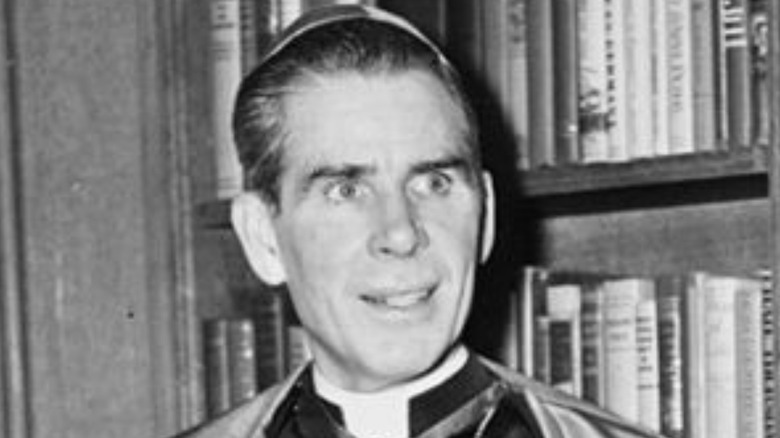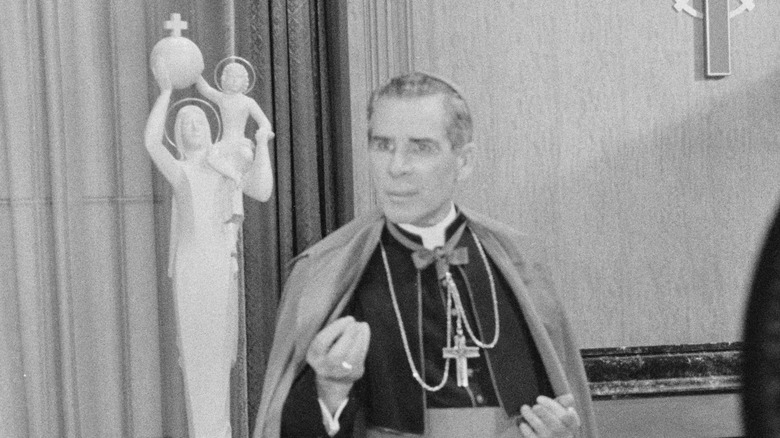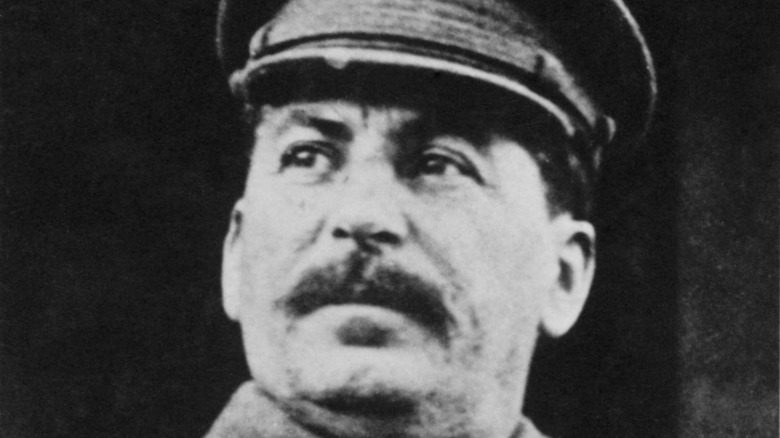The Untold Truth Of Archbishop Fulton J. Sheen
Close your eyes and picture a televangelist. What does he look like? Shiny polyester suit? Mile-high, rock-hard hair? Pained expression on his face as he yells something about a revelation he just got from the Holy Spirit?
It turns out the man usually credited as the "first televangelist" (via AP News) was actually nothing like that, unless you count his association with Christianity. The first individual to preach the Christian gospel on television was a Catholic archbishop named Fulton J. Sheen. Originally ordained as a priest in Peoria, before later becoming auxiliary bishop of New York, bishop of Rochester, and finally archbishop of the "titular see" of Newport, Wales, Archbishop Sheen actually made his greatest mark as a television personality, speaking weekly to viewers about theology, philosophy, and politics.
Beginning on radio with NBC's "The Catholic Hour," Sheen eventually leaped to prime time television with his show "Life is Worth Living," which aired first on the DuMont network and later on ABC. In contrast to later, flashier Christian TV, Sheen's program was a simple one, where the former philosophy professor stood between a fireplace and a chalkboard in his formal robes, lecturing a live audience off the cuff (via Britannica). Despite (or because of) this simplicity, "Life is Worth Living" managed to outperform most competing shows in the ratings, and even won Archbishop Sheen an Emmy.
He beat Milton Berle and Frank Sinatra in the ratings
Sheen had done well enough on the radio, but when he made the transition to television there wasn't a lot of faith in his ability to draw in viewers. He was given an 8 p.m. Tuesday slot, which might seem like prime real estate, but only if you're unaware of whom he was going up against. Eight on Tuesdays was the slot in which ABC was airing "The Frank Sinatra Show" and NBC was countering with Milton Berle's "Texaco Star Theater." It was a duel to the death between mega-stars, and Bishop Sheen had essentially been sent out into the crossfire to die.
With that in mind, it's probably no surprise that "Life is Worth Living" was originally picked up by only three DuMont affiliates. As Sheen began to pull viewers away from Berle and Sinatra, though, it gained steam, and within two months was airing on 15 channels — quite a few in 1952.
As Berle's formerly stellar ratings declined and Sheen's increased, Berle was pretty philosophical about it. "If I'm going to be eased off TV by anyone," he commented, "it's better that I lose to the one for whom Bishop Sheen is speaking." Berle got in a few quips as well, commenting that "We both work for Sky Chief" (in reference to Texaco's flagship line of gasoline) and — when he was accused of recycling old material — adding that "[Sheen] uses old material too" (via Rick Marschall).
He won an Emmy
While it's hard to imagine a priest giving lectures on philosophy blowing up ratings in the modern world, it's important to remember that the 1950s were a very different time — in part, there just wasn't very much to watch on television. Still, the fact that viewers chose Sheen over Sinatra or Berle is probably indicative of Sheen's ability to explain the Catholic faith in ways that were engaging and easy to understand, without shying away from heady topics.
Fundamentally, when he spoke, he was speaking to a universal audience, not just the Catholic faithful. "Starting with something that was common to the audience and me, I would gradually proceed from the known to the unknown or to the moral and Christian philosophy," he would later say. "When I began television nationally and on a commercial basis, I was no longer talking in the name of the church" (via Archbishop Fulton John Sheen Spiritual Centre).
Whatever the reason, though, Sheen's formula of philosophy, theology, jokes, cassocks, skullcaps, and blackboards struck enough of a chord that in 1953 he managed to score an Emmy in the category of "Outstanding TV Personality" (via Emmys.com), beating out personalities that included Edward Murrow, Arthur Godfrey, and Lucille Ball (via Catholic University of America). Accepting the award, Sheen joked, "I wish to thank my four writers, Matthew, Mark, Luke and John."
He predicted Stalin's death
Bishop Sheen didn't restrict himself to esoteric theological topics; he often commented on contemporary politics as well. One of the recurring themes of the show was Sheen's hatred of Stalinist Communism — often to a fault (Per The New York Times, the stance led him to support Spanish fascist general Francisco Franco Bahamonde, simply because he opposed Communism. Not a great look.)
On October 7, 1952 — in an unusually dramatic moment for the show — Bishop Sheen read through Julius Caesar's death sequence from William Shakespeare's tragedy, replacing Caesar's name with Stalin's and the other names with those of high-ranking Soviet officials. Closing the book, Sheen concluded that Stalin would one day die, stand before God, and have to answer for what he had done in his life (via Christopher Owen Lynch). Within a few days of the broadcast, Stalin had suffered a stroke, and less than a week after that, he was dead (via Snopes).
Stalin was 74 years old at the time, and in poor health, so predicting his death was sort of like predicting that the sun would rise in the morning — but still. It's hard to imagine a better sendoff for the guy.
He's been credited with a miracle
Since Sheen's death in 1979, there have been rumblings from supporters looking to have him canonized as a saint, which probably isn't surprising, given how popular he was in his life. Unfortunately for him and his followers, though, being recognized as a saint — canonized — by the Catholic Church comes with certain requirements. Among other things, you have to be credited with performing at least two posthumous miracles.
On September 15, 2010, however, the bishop managed to get halfway there, when Peoria resident Bonnie Engstrom gave birth to her son James Fulton. The pregnancy had been easy, and the child had seemed healthy up until the birth, when somehow a knot formed in the umbilical cord. James was born with no cardiopulmonary activity and remained unresponsive for more than an hour. His mother prayed constantly for Bishop Sheen's intercession, but at 61 minutes, the hospital staff was ready to pronounce her son dead.
And then his heart began to beat. Doctors cautioned the parents that their son would probably be blind, or else unable to walk or feed himself, but James made a full recovery and, as of 2019, was described by America: A Jesuit Review as "a healthy 8-year-old who likes chicken nuggets, 'Star Wars' and riding his bicycle."
For anyone keeping score, that's still one miracle short of (potential) official sainthood, but it was enough to get Pope Benedict XVI to declare him "venerable" (via Diocese of Brooklyn).
There was a big fight over his body
While the Church has publicly deemphasized it some since the Protestant Reformation, Catholicism places a high value on the value of the human body that certain Protestants and non-Christians often find off-putting. The thinking goes that Christ becoming human sanctified the physical along with the spiritual. Scripture speaks of body parts or possessions of particularly holy people — relics — healing the sick and even raising the dead (via EWTN). While the belief is not all that difficult to understand, it does occasionally result in public embarrassment, such as when public fights happen over relics.
Such has been the case with Sheen's remains. While the archbishop has yet to pass beyond "venerable" status, the fight over his body and its potentially associated relics has been strangely heated and strangely public. Archbishop Sheen was initially interred in the crypt beneath the altar of St. Patrick's Cathedral in New York. As it became clear that no one in the New York Archdiocese was interested in spearheading the initiative for sainthood, his family and supporters grew increasingly anxious to have his body moved to Peoria to streamline the process. When New York's Archdiocese refused and accused Peoria's of looking to "dismember" his corpse for relics (via the National Catholic Reporter), the controversy erupted into a lawsuit at the New York Supreme Court (via NBC News).
The court ruled in Peoria's favor, and in 2019 his remains were reinterred at Peoria's Cathedral of St. Mary of the Immaculate Conception (via The Catholic Post).





